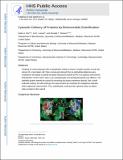| dc.contributor.author | Lomax, Jo E. | |
| dc.contributor.author | Mix, Kalie | |
| dc.contributor.author | Raines, Ronald T | |
| dc.date.accessioned | 2018-10-01T17:19:24Z | |
| dc.date.available | 2018-10-01T17:19:24Z | |
| dc.date.issued | 2017-10 | |
| dc.date.submitted | 2017-06 | |
| dc.identifier.issn | 0002-7863 | |
| dc.identifier.issn | 1520-5126 | |
| dc.identifier.uri | http://hdl.handle.net/1721.1/118315 | |
| dc.description.abstract | Cloaking its carboxyl groups with a hydrophobic moiety is shown to enable a protein to enter the cytosol of a mammalian cell. Diazo compounds derived from (p-methylphenyl)glycine were screened for the ability to esterify the green fluorescent protein (GFP) in an aqueous environment. Esterification of GFP with 2-diazo-2-(p-methylphenyl)-N,N-dimethylacetamide was efficient. The esterified protein entered the cytosol by traversing the plasma membrane directly, like a small-molecule prodrug. As with prodrugs, the nascent esters are substrates for endogenous esterases, which regenerate native protein. Thus, esterification could provide a general means to deliver native proteins to the cytosol. | en_US |
| dc.description.sponsorship | National Institutes of Health (U.S.) (Molecular Biosciences Training Grant T32 GM007215) | en_US |
| dc.description.sponsorship | National Institutes of Health (U.S.) (R01 GM044783) | en_US |
| dc.language.iso | en_US | |
| dc.publisher | American Chemical Society | en_US |
| dc.relation.isversionof | http://dx.doi.org/10.1021/jacs.7b06597 | en_US |
| dc.rights | Article is made available in accordance with the publisher's policy and may be subject to US copyright law. Please refer to the publisher's site for terms of use. | en_US |
| dc.source | Prof. Raines | en_US |
| dc.title | Cytosolic Delivery of Proteins by Bioreversible Esterification | en_US |
| dc.type | Article | en_US |
| dc.identifier.citation | Mix, Kalie A., et al. “Cytosolic Delivery of Proteins by Bioreversible Esterification.” Journal of the American Chemical Society, vol. 139, no. 41, Oct. 2017, pp. 14396–98 | en_US |
| dc.contributor.department | Massachusetts Institute of Technology. Department of Chemistry | en_US |
| dc.contributor.approver | Raines, Ronald T. | en_US |
| dc.contributor.mitauthor | Mix, Kalie | |
| dc.contributor.mitauthor | Raines, Ronald T | |
| dc.relation.journal | Journal of the American Chemical Society | en_US |
| dc.eprint.version | Author's final manuscript | en_US |
| dc.type.uri | http://purl.org/eprint/type/JournalArticle | en_US |
| eprint.status | http://purl.org/eprint/status/PeerReviewed | en_US |
| dspace.orderedauthors | Mix, Kalie A.; Lomax, Jo E.; Raines, Ronald T. | en_US |
| dspace.embargo.terms | N | en_US |
| dc.identifier.orcid | https://orcid.org/0000-0002-2836-5744 | |
| dc.identifier.orcid | https://orcid.org/0000-0001-7164-1719 | |
| mit.license | PUBLISHER_POLICY | en_US |
